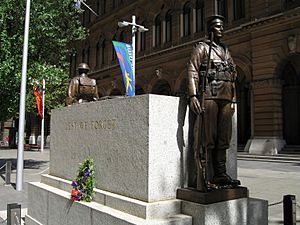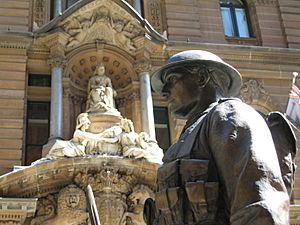Sydney Cenotaph facts for kids
The Sydney Cenotaph is a special monument in Martin Place, Sydney, Australia. It's like a memorial that helps us remember people who died in wars. It was designed by Bertram Mackennal and built between 1927 and 1929. You might also hear it called the Martin Place Memorial or just The Cenotaph. It's one of the oldest monuments in central Sydney that remembers World War I. This important site was added to the New South Wales State Heritage Register in 2009.
A cenotaph is like an "empty tomb." It's a monument that honors people whose bodies are buried somewhere else, or who were lost in war and have no known grave. The Sydney Cenotaph is a large stone block. On its shorter sides, you'll see two bronze statues: a soldier and a sailor. They stand guard over the monument. On one side, it says: "To Our Glorious Dead." On the other side, it reads: "Lest We Forget." Many important events are held here, especially the main Anzac Day and Armistice Day ceremonies. Thousands of people come to remember and honor those who served.
Contents
Remembering Our History
In 1914, Australia decided to help the United Kingdom when a big war started. This war became known as World War I, or the Great War. Australian soldiers fought far from home in places like the Middle East and Europe. Many soldiers were hurt or died. By the end of the war in 1918, about 65% of the Australians who went overseas were casualties. This meant many families and communities felt great sadness.
Why the Cenotaph Was Built
Sydney needed a special place for people to remember and mourn the soldiers lost in the Great War. The bigger Anzac War Memorial in Hyde Park was not ready yet. So, the Cenotaph was built in Martin Place. This spot was chosen because many rallies and events for the war had happened there. In 1924, a man named Fred Davison suggested building a memorial in Martin Place. The Premier of New South Wales, Jack Lang, agreed in 1925 and set aside money for it.
The Martin Place Cenotaph is different from many other war memorials. It doesn't list individual names. Instead, it remembers everyone who made the ultimate sacrifice in war. It was inspired by a famous cenotaph in London designed by Edwin Lutyens. That monument also had simple words: "The Glorious Dead." The London Cenotaph was so powerful that people wanted a permanent version.
It was unusual for the NSW Government to pay for a war memorial. Usually, local groups raised money for them. Premier Lang wanted to show he supported soldiers. The Cenotaph was placed in Martin Place to connect directly with the wartime events that happened there.
A special committee helped with the project. Instead of holding a design competition, Premier Lang asked sculptor Sir Bertram Mackennal to design it. Mackennal was a famous artist who had designed other important sculptures.
Designing the Memorial
For the Sydney Cenotaph, Mackennal created a strong, rectangular stone block. It was guarded by a soldier and a sailor. Some people didn't like the design at first. They thought it was too simple or that the statues looked too realistic. However, Mackennal explained that the figures were "guarding altar of remembrance," not mourning. Many people later found comfort in its simple design.
In 1927, Dorman Long & Co built the granite base. John Bradfield, a famous engineer, helped supervise. The large granite block came from a quarry in Moruya. Skilled stonemasons carefully prepared and carved the stone.
The monument features two bronze statues of servicemen. They were modeled after real soldiers who had served. The soldier statue was based on Private William Pigott Darby, who fought at Gallipoli. The sailor statue was based on Leading Signalman John William Varcoe, who served in the Royal Australian Navy.
Private Darby was born in Ireland in 1872. He joined the Australian army in 1914, even though he was older than he said. He landed at Gallipoli on his 43rd birthday in 1915. He was a stretcher-bearer and later served at the Somme. He was injured and returned to Australia in 1918.
Leading Seaman Varcoe was born in 1897. He joined the Royal Australian Navy in 1913. He served on several ships, including HMAS Parramatta (D55). In 1917, he helped rescue people from a torpedoed Italian ship. For his bravery, he received the Distinguished Service Medal.
Opening the Cenotaph
The Cenotaph was officially opened on February 21, 1929. The Premier of NSW, Thomas Bavin, unveiled it. Sir John Monash, a famous general, gave a speech. The monument is made of granite and weighs about 20 tons.
The First Dawn Service
The famous Anzac Day Dawn Service started because of the Cenotaph. On Anzac Day in 1927, five returned soldiers saw an elderly woman placing a wreath at the unfinished Cenotaph at dawn. They were moved by this quiet moment. They decided to hold an official service at dawn the next year, on April 25, 1928.
This first Dawn Service began at 4:30 AM, the same time the first Anzacs landed at Gallipoli. It was a chance to lay wreaths and remember in silence. Even though it wasn't advertised, 150 people came. The next year, more people attended, and a bugler played. By 1931, the Governor of NSW attended, making it even more official. Today, the Dawn Service at the Sydney Cenotaph still attracts huge crowds every year.
The idea of the Dawn Service spread to other parts of Australia. The rising sun at dawn reminds us of new beginnings and the bravery of soldiers. The Cenotaph quickly became a very important place for remembering those lost in war in NSW.
The Cenotaph is not just for Australians. Important visitors from other countries often place wreaths there. For example, in 1942, American soldiers in Australia laid wreaths on US Independence Day. They remembered American troops who died defending the Philippines.
Over the years, there were ideas to add more statues or move the Cenotaph, but these plans never happened. Chains and bollards were added around it for protection. The area around the Cenotaph in Martin Place became a pedestrian plaza, which helped protect the monument from traffic.
What the Cenotaph Looks Like
The Cenotaph in Martin Place is a simple but powerful memorial. It's a large granite altar with a bronze statue of a serviceman at each end. The stone block is about 3 meters long, 1.65 meters wide, and 1.25 meters high. It sits on a stepped base.
The statues of the soldier and sailor are larger than life-size. They were created by Bertram Mackennal. The soldier faces east, and the sailor faces west. Both are shown realistically in their uniforms, carrying their gear. They stand in an "at ease" position, guarding the Cenotaph. On top of the altar is a bronze wreath. Each serviceman faces a flagpole a few meters away.
On the north side of the Cenotaph, the words "TO OUR GLORIOUS DEAD" are carved. On the south side, it says: "LEST WE FORGET." A low fence of metal posts connected by chains surrounds the Cenotaph and flagpoles. White poplar trees were planted near the ends of the monument in the 1970s.
Why the Cenotaph is Important
The Sydney Cenotaph is very important to the history of New South Wales. It helps us remember the many Australian lives lost in World War I and other conflicts. It also played a key role in starting the Anzac Day "Dawn Service" in 1928. This tradition is now observed all over Australia and even overseas.
Unlike most other war memorials, the Cenotaph doesn't name individuals. Instead, it honors the shared sacrifice of everyone who died in war. This makes it both special and unique. It reminds us of the deep sadness felt by communities after the Great War.
The Cenotaph is also important because of its design. It's an Australian version of the famous London Cenotaph. Its simple granite block and guarding statues show great artistic skill. Even though some people found it too plain at first, its simplicity has helped many people find comfort over the years.
This monument is a central place for memorial services in NSW. Many groups, including veterans' organizations like the Returned & Services League (RSL), use it to remember. Its role in starting the Dawn Service makes it a powerful symbol of remembrance. Located in a busy part of Sydney, it constantly reminds us of the sacrifices Australians have made in wars.
The Cenotaph is rare because it was funded by the State Government, not just local groups. It stands as one of the most important monuments in NSW, alongside the Anzac Memorial in Hyde Park. It represents the sacrifices made by all who served, not just specific individuals.
See also
 In Spanish: Cenotafio de Sídney para niños
In Spanish: Cenotafio de Sídney para niños



